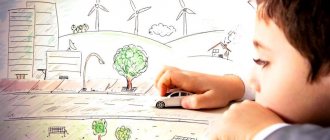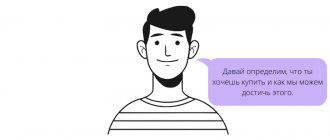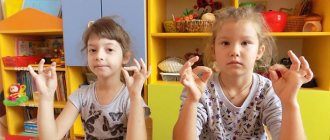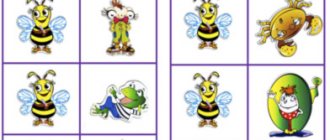Mechanism and types of perception
For the full development and effective learning of a child, a sufficient level of development of perception is necessary. It is the basis for the formation of other cognitive processes (memory, attention, thinking, speech and imagination). How does the process of perception occur?
- The world around us consists of various objects and phenomena that can be seen, heard, touched, tasted, smelled.
- With the help of our senses we learn about what an object is. For example, an orange has the following properties: round, orange, smooth, with small dimples on the peel, sour, and has a specific citrus smell.
- Information from the senses enters the brain, where individual sensations are combined into a holistic “picture” - perception.
- Perception is greatly influenced by accumulated life experience. If a child has already seen and eaten an orange, he does not need to taste it to guess what it is.
Classification of types of perception:
- Visual perception allows you to obtain a visual image of an object, as well as study its details;
- Auditory perception makes it possible to understand speech, recognize various sounds of nature, household noises and hear music;
- Tactile perception - cognition of objects through touch;
- Olfactory perception – recognition of odors;
- Taste perception – receiving information from taste buds (perception of sweet, salty, sour and bitter).
Most experts believe that each of us has a leading channel for receiving “data” about the world (usually vision, hearing or touch). Pay attention to the form in which your baby absorbs information better - this should be the main one in his learning.
Properties of perception
Among the leading qualities of perception, the following parameters are reflected:
- Concreteness, that is, the ability to reflect various objects and processes of the real world in the form of separate objects.
- Solidity or completeness, that is, the reflection of objects in the complex of their properties.
- Structurality is a feature that is demonstrated in the fact that the personality assimilates, so to speak, a collective device that is formed over a certain time period, isolated from the emerging sensations.
- Stability, expressed in the constancy of specific parameters of objects in combination with varying conditions of their perception.
- Rationality, that is, the existence of a relationship with thought processes.
- Initiative (or selectivity), which consists in the perception of only one object or group of objects in a certain time period.
Peculiarities of perception in early preschool age (3-4 years)
The perception of 3-4 year old children is characterized by specificity and lack of clarity. The main parameters of perception in early preschool age are color, shape and size. Most often, children pay attention to the most striking of these signs, and the rest of the details are guessed by them. For example, seeing buttons with numbers on the TV remote control, children often decide that it is a telephone. It is interesting that three-year-olds do not recognize even the closest people if they are dressed in carnival costumes. At this age, children clearly distinguish primary colors (red, yellow, blue, green). Little-known shades are perceived as unimportant signs, and therefore are often simply ignored. However, kids learn quickly and remember everything on the fly. The more color standards you introduce your child to, the brighter the baby’s perception will be. Sometimes children evaluate the color characteristics of objects as “beautiful” and “ugly”, so in drawing you can see the child’s color preferences, and not real images of objects.
The properties of objects for younger preschoolers are inseparable from the things themselves, so they are firmly fixed in perception. For example, a baby knows that a cucumber is always green, and can call zucchini, avocado, and green beans cucumbers.
In children of this age, their perception of space is formed through actions with objects. A 3-year-old child is just beginning to distinguish between the concepts of “far” and “close”, so he has difficulty assessing the size of distant objects. For example, looking at the panorama of the city, a child may well think that the houses are toy. To develop the baby’s spatial understanding, you need to pay his attention to his own body (the child will quickly remember that the legs are below, the head is above, and the arms are at the side), and also more often give the child requests indicating the direction (for example, “turn right” , “take the candy from the top shelf” and so on).
Visual perception
Visual perception is one of the most important. According to research, vision supplies us with more than 80% of information, and 20% comes from the other senses.
Visual perception is based on a person’s ability to sense light flows, and light of different wavelengths, reflected from objects, causes different color sensations.
Humans may have less sensitivity to light than a cat and a shorter visual range than an eagle, but human perception has many unique and useful features.
Color vision
Color is nothing but light of different wavelengths, but it has a huge significance in our lives.
Color perception is so important for humans that the color around us can influence:
- our mood;
- performance;
- and even on physical condition.
In an environment poor in colors, a person experiences “color starvation,” and young children even experience mental retardation (read about the specifics of the influence of colors here).
Higher animals are also capable of distinguishing colors, but their abilities in this are not comparable to humans. Even an ordinary, untrained person can easily distinguish 150 shades. And colorists are able to see more than 10 thousand colors.
Meaningful vision
People don't just perceive light signals; our brains constantly process visual information. Visual perception is conscious. We think everyone has encountered a situation when, having seen an unfamiliar object, we painfully try to understand what it is, rummaging through our memory, trying to find something similar there or to evoke an association with a familiar object.
Unlike humans, animals react only to objects that are significant to them, and evaluate unfamiliar ones according to their degree of danger or edibility.
Types of visual perception
Visual perception is diverse, and within this perceptual process several types are distinguished.
- Shape perception, which relates to a person's ability to differentiate between a basic figure and a ground. They can change places, depending on the significance and focus of attention. For example, a book lying on a table littered with papers, pens, notepads and other objects can be perceived by us as the central object, and the rest will be the background. But if we need, say, a pen, then it will become the object. Although this only applies to space filled with approximately homogeneous objects.
- The perception of space is also a special type of visual perception. It includes the ability to see the depth, volume, distance of objects and their shape. It is interesting that a two-dimensional image of an object appears on the retina of the eye, and its three-dimensional image is formed in the visual part of the brain. This ability is believed to be related to binocular vision, and the 3D-effect image is created by superimposing two “pictures” from each eye, as in a stereoscope.
However, everything is much more complicated. After all, if a person loses the ability to see with one eye, then the picture still remains three-dimensional and three-dimensional, just like the perception of the depth of space. Our brain compensates for the missing information with that stored in memory and completes the image to the required “three-dimensionality.”
But visual perception has not yet been fully studied; there is a lot of incomprehensible and even mysterious things in it. For example, how do we see moving objects?
- Most researchers believe that information about the movement of objects comes to the brain from the nerve endings of the eye muscles when it moves behind the object.
- Other scientists believe that the perception of motion is associated with the movement of an image across the retina.
How do children of middle preschool age (4-5 years old) perceive the world?
By the age of 5, children achieve significant success in their ability to perceive various parameters of the world around them:
- There are 7 or more colors;
- Have an idea of light and dark tones, “warm” and “cold” shades;
- Know the basic geometric shapes (circle, square, triangle, rectangle);
- Can compare objects by size (large, smaller, small);
- They begin to form the concept of time (today, yesterday, tomorrow, minutes, hours, days, weeks), but they are not yet able to apply knowledge about these abstract concepts into the life of a four-year-old;
- The perception of other people depends on their popularity in society and their relationship with the baby. Mom will always be perceived by the baby as the kindest and most beautiful.
Channels of information perception
The channels of perception mean the predominant direction towards one sense organ, which ensures better assimilation of incoming information. It is worth considering the factor that each person has his own individual orientation. For some, it is enough to read the material once to master it, for others it is necessary to listen to a lecturer on the same topic, etc.
Visual channel. Aimed at assimilation of information by focusing more on visual images. A person who is dominated by this channel of perception has a high ability to absorb information through reading. In this case, it is enough for the individual to read the material, and the information will be firmly “fixed” in the brain. There is no need to retell what you read or share with others. If the information itself is contradictory, raises additional questions, or provokes a dispute, then the individual may need to familiarize himself in detail with different opinions in order to form his own point of view.
Auditory channel. Aimed at assimilating information by concentrating primarily on auditory images. If this channel of perception predominates, a person has a high ability to remember through listening to the desired material. Students whose auditory channel dominates perfectly absorb the proposed information during a lecture and don’t have to study anything at home - everything is already easy in their head, so there are no unnecessary questions left! If difficult moments arise, the material is complex and incomprehensible, such a person usually strives to immediately clarify important details and figure it out on the spot by asking the lecturer the appropriate questions.
Kinesthetic channel. Aimed at assimilation of information by focusing primarily on physical sensations. Kinesthetic perception is closely related to the organs of touch, so such a person must touch the interlocutor during a conversation. Smell and taste are also of paramount importance for this person - she is most attentive to details and her own feelings. If you ask a person what is happening to him, he will be able to describe his emotions in colors and recognize their true manifestations.
Digital channel. Aimed at assimilation of information by concentrating on abstract-logical images. Such a person is inclined to look for meaning in everything, to sort his knowledge “on shelves”
It is extremely important for a digital person to know for what purpose he performs this or that action and what will follow from it. He has the ability to predict the situation, and therefore is prone to planning and in-depth analysis of current events
Most often, digital people are engaged in scientific activities throughout their lives.
The listed channels of perception are leading, but besides them there are others: gustatory, olfactory, semantic, etc. In accordance with the presented features of each channel, psychology distinguishes the following types of information perception: visual, auditory, tactile, verbal. Each of the listed types is fully correlated with the above-mentioned channels of information perception.
Peculiarities of perception in older preschool age (5-7 years)
In older preschool age, as before, visual sensations dominate perception. Auditory perception begins to actively develop: children are able to identify sounds in words, recognize familiar musical compositions, and feel the tempo and rhythm of a piece. Six-year-old children are well oriented in space (they practically do not confuse “right” and “left”, perceive distances between objects quite accurately, and can navigate plans and diagrams). The perception of time periods (minute, hour, day, and so on) depends on how often parents mention them in communication with their children. If you give your child tasks in which time is one of the guidelines (for example, “draw as many circles as possible in a minute” or “you need to brush your teeth for 2 minutes”), gradually it will no longer be so incomprehensible to the child.
The leading channel of perception for most older preschoolers is vision. At the same time, other types of sensitivity (especially auditory and tactile) are also actively developing.
Psychological theories and schools
Perception disorders have been studied by representatives of various psychological schools.
They used different theoretical bases as well as practical techniques.
- The first to emerge was the teaching of the structuralists. They were I. Muller, G. Helmholtz, E. Goering and E. B. Titchener. They believed that a holistic image of an object in a person’s mind is formed from a combination of sensations received from various analyzers.
The structuralist technique was called analytical introspection. With its help, they studied sensations—the “bricks” from which perception is built. They decomposed one image into separate perceptible parts and studied them in natural conditions. And they noticed that with similar sensations, a combined perception of different objects is formed by associative means.
- Gestalt psychologists became critics of the structuralists. Prominent representatives were M. Wertheimer, W. Keller and K. Koffka. In their opinion, a person perceives objects, objects and the situation as a whole as if they were a single complex of external stimuli. Their technique was called phenomenological, when a person was asked to describe the full range of his sensations. Moreover, in similarly perceived situations, it was believed that similar processes occur in the brain. Gestaltists also considered all sensations to be innate.
- The ecological theory of perception was proposed by J. Gibson. According to it, the environment is actively explored by man through an active search by man for signals from the outside world. It is the streams of stimuli that give rise to sensations that shape perception. Perception itself is interpreted as a means of human adaptation to the outside world.
- In 1961, J. Piaget, working with children, came to the conclusion that perception is a property of the psyche that develops throughout human life. With its help, a person gradually learns to isolate and find common details from incoming sensations, as well as to control his movements in accordance with the information received.
Games and exercises for developing perception in preschoolers
Play is the leading activity in preschool age. This is why exercises and games are an effective and fun way to develop children's perception.
- Sorting by color, shape, size. Items for sorting can be any available materials: toys, lids, construction parts, cubes, buttons, cereals, pencils, etc. You can organize the game in various ways: placing objects in bowls, “hiding” an object (arranging objects so that they blend into the background), throwing objects into holes of the desired color/shape/size.
- "What is missing". This exercise develops visual perception, thinking and attention to detail. Draw several objects or animals on a piece of paper, but do not finish drawing them. One or more essential features of the objects must be missing (for example, a hare without ears, a table without legs, a car without wheels), and the baby’s task is to say what is missing in the picture.
- "Confusion." Show your child a picture with the contours of familiar objects superimposed on each other. The child must name everyone who is depicted on it.
Regular exercises will help your child develop a high level of various types of perception.
- Puzzles and cut-out pictures. These games, in which the child needs to assemble a whole picture from pieces, are excellent for developing visual perception.
- "Guess by the smell." From available ingredients you can create a whole aroma set (for example, garlic, coffee, cinnamon, berries, cucumber, lemon, chocolate, and so on). Ask your baby to close his eyes and guess the object by smell. You can also invite your child to draw what he associates this or that scent with.
- “Whose sound?” An adult hides behind a screen and uses objects to make various sounds: rustling a bag, tearing paper, knocking with spoons, ringing a bell, pouring water, and so on. The baby must guess which object each sound corresponds to.
- "Magic bag" For this game you will need an opaque bag and small objects of various shapes and textures. Based on his tactile sensations, the baby should pull out the thing that you describe to him.
How does visual perception develop as a child ages?
The younger preschool age turns out to be the most important for the development of visual perception. The child’s character of research and orientation activity changes; he moves from the simplest manipulation of an object to a more detailed familiarization with it through touch and vision.
In 3-7 year old children, the most important distinctive feature of perception is that it becomes leading, combining the experience of numerous indicative actions. It already allows you to cover many details, to grasp their qualities and relationships. The process of viewing is formed, because at an earlier age children almost do not examine objects or manipulate them. However, the baby still cannot control his gaze, so he wanders randomly around the object. The perception of 3-4 year old children is controlled by the teacher in the process of various activities. The most important way to examine objects is a chain of perceptual actions.
By the age of 5-6 years, the perception of space changes significantly. Children increasingly want to understand the variety of forms they encounter and try to establish what a given object looks like. Adults should help them with this
Children can already compare the lengths of lines quite successfully, but when solving more complex problems using the eye, things are still not going well. It is better to improve the eye gauge when engaged in construction, when the child needs to select missing parts for construction or, during sculpting, divide a piece of clay so that there is enough of it for all elements of the object.
You can also exercise your eye through games, drawing, and applications. During the examination, the properties of the perceived object seem to be translated into the language of the system of sensory standards that the baby understands. By sensory standards we mean ideas about the properties of objects perceived sensually. These ideas are characterized by generality, since they reflect the most important, essential qualities. Standards do not exist separately, but form certain systems, such as a system of geometric shapes, a spectrum of colors, etc. The understanding of standards is expressed through their name, that is, a word, therefore the connection of perception with speech and thinking causes its intellectualization. At 6-7 years old, the child has almost formed all types of analyzers, and with their help, all types of sensitivity continue to develop. Visual sensations and perceptions are especially important at this age. It is known that a child receives up to 80% of all information about the world around him through vision. By the age of 6, there are much fewer errors when distinguishing colors. At 6-7 years old, in addition to the primary colors, a child knows a number of shades. For five-year-olds, perception is still involuntary. But by the age of seven, children can already set themselves the task of studying a subject and comparing it with others.
In child psychology, the question remains debatable about what the child relies on when perceiving an object: recognition of its individual parts or a holistic reflection
For a child’s productive perception of an object, the action that the child uses in the process of perception is very important. As a result of this process, he acquires personal experience, while simultaneously assimilating collective experience
Thus, with the development of perception, not only does its volume, accuracy, and meaningfulness change, but the method of perception itself undergoes restructuring and becomes more and more perfect.
conclusions
At preschool age, children experience a colossal leap in mental development, because during this period all cognitive processes are actively formed. Perception is the basic mental process on the basis of which all others (attention, thinking, speech, memory and imagination) are formed. Over the course of several years, children go from direct sensory perception to the ability to form a generalized idea of objects. If initially a child learns to recognize and evaluate what is in front of him at the moment, based on his own sensations and experience, then in older preschool age the level of development of perception allows him to purposefully study objects or phenomena, highlighting their properties. It is necessary to pay enough attention to the development of perception in children, because the child’s ability to learn largely depends on its level.
What is perception: definition of the concept
Perception is a cognitive process that forms in our minds a certain picture of the world around us.
Moreover, this picture is not objective, but is subjective in nature, that is, colored by personal impressions.
This process is also called perception, it begins with the action of our senses: vision, hearing, touch, etc., when we receive primary information about some object or phenomenon.
At this stage of perception, which is called the lower level, the cognition of the world by the simplest stops.
But vertebrates, for example, are capable of not only receiving certain information, but also analyzing it, evaluating it from the point of view of perceived danger, usefulness, or motivation for some activity or movement.
In humans this process is most fully expressed. Comprehension of information received from the senses has many stages and types.
Such a truly intelligent perception of the surrounding world is its highest level, it is called apperception.
The type of thinking based on the direct perception of objects is called visual-effective.







